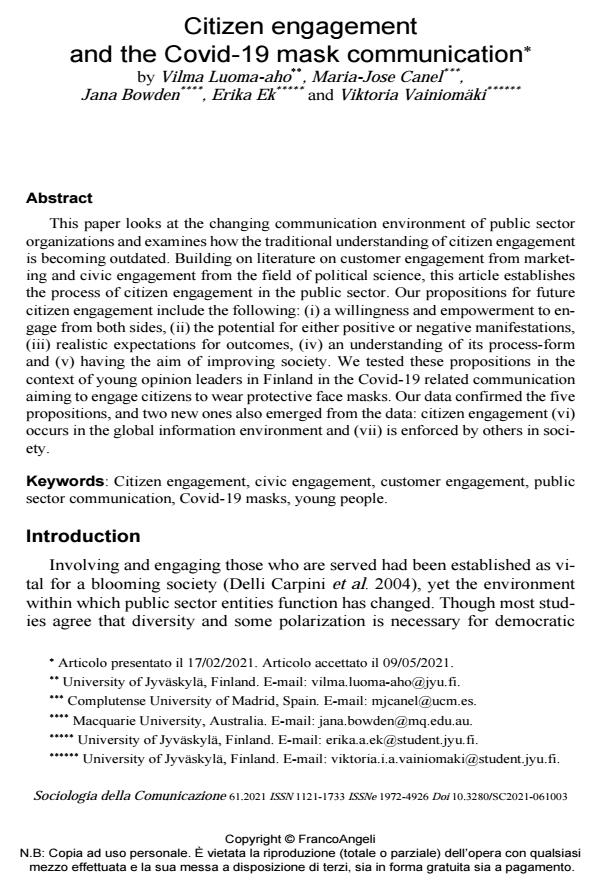Citizen engagement and the Covid-19 mask communication
Titolo Rivista SOCIOLOGIA DELLA COMUNICAZIONE
Autori/Curatori Vilma Luoma-aho, Maria-Jose Canel, Jana Bowden, Erika Ek, Viktoria Vainiomäki
Anno di pubblicazione 2021 Fascicolo 2021/61
Lingua Inglese Numero pagine 16 P. 20-35 Dimensione file 392 KB
DOI 10.3280/SC2021-061003
Il DOI è il codice a barre della proprietà intellettuale: per saperne di più
clicca qui
Qui sotto puoi vedere in anteprima la prima pagina di questo articolo.
Se questo articolo ti interessa, lo puoi acquistare (e scaricare in formato pdf) seguendo le facili indicazioni per acquistare il download credit. Acquista Download Credits per scaricare questo Articolo in formato PDF

FrancoAngeli è membro della Publishers International Linking Association, Inc (PILA)associazione indipendente e non profit per facilitare (attraverso i servizi tecnologici implementati da CrossRef.org) l’accesso degli studiosi ai contenuti digitali nelle pubblicazioni professionali e scientifiche
This paper looks at the changing communication environment of public sector organizations and examines how the traditional understanding of citizen engage-ment is becoming outdated. Building on literature on customer engagement from marketing and civic engagement from the field of political science, this article es-tablishes the process of citizen engagement in the public sector. Our propositions for future citizen engagement include the following: (i) a willingness and empow-erment to engage from both sides, (ii) the potential for either positive or negative manifestations, (iii) realistic expectations for outcomes, (iv) an understanding of its process-form and (v) having the aim of improving society. We tested these propo-sitions in the context of young opinion leaders in Finland in the Covid-19 related communication aiming to engage citizens to wear protective face masks. Our data confirmed the five propositions, and two new ones also emerged from the data: citizen engagement (vi) occurs in the global information environment and (vii) is enforced by others in society.
Parole chiave:Citizen engagement, civic engagement, customer engagement, public sector communication, Covid-19 masks, young people
- Towards a conversational public administration? Giulia Banfi, Marco Luca Pedroni, in RDBCI: Revista Digital de Biblioteconomia e Ciência da Informação /2025 pp.e026005
DOI: 10.20396/rdbci.v24i00.8680284
Vilma Luoma-aho, Maria-Jose Canel, Jana Bowden, Erika Ek, Viktoria Vainiomäki, Citizen engagement and the Covid-19 mask communication in "SOCIOLOGIA DELLA COMUNICAZIONE " 61/2021, pp 20-35, DOI: 10.3280/SC2021-061003